Reflecting on my childhood journey to Thailand
“Club Tropic Karma on the island of Koh Fun, southern Thailand, is a new luxury dive and spa destination owned by British property magnate Rich Long. Eight guests gather in the Beachview bar in the early evening; each has received an anonymous invitation. That morning the body of Bang, the hotel masseur has been found on the beach. She was discovered by hotel staff at 6am, but no alarm was sounded or police called. Two half-finished cocktails were near the body, along with a mysterious symbol drawn in the sand. As the last to leave the bar the previous night, all eight guests are suspects. One is a murderer. At Club Tropic Karma, drinks may be free but they come at a price…”
This was the brief that my friend Jigna sent to me, along with an invitation for an online murder mystery dinner. The only thing I had to do was to prepare a three-course Thai meal for one, and dress up as my character. I was Bjorn, a Scandinavian by birth, who had lived on the (fictional) island of Koh Fun for the last twenty years. This is where the differences between myself and Bjorn end. A converted Buddhist and eco-warrior, Bjorn loves Thailand and the Thai people and passionately opposes to the deforestation that development is bringing to the island. He also practices Tibetan tantric yoga every morning on the beach (well, I may not be lucky enough to practice yoga on a beach, but I do so in my flat in London).
My childhood journey to Thailand
Unsurprisingly, this murder mystery dinner traveled me back to Thailand, a country that I’d visited twice, first when I was eight years old, and once again the following year. That journey to Thailand was such an enlightening, mind-altering and character-shaping experience for me.
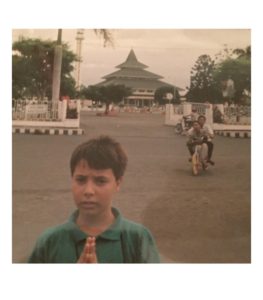
A spiritual and enlightening journey
It was the first time in my life that I visited non-Orthodox places of worship and came in direct contact with a different religion. Amongst those places of worship, was the temple of Wat Traimit in Bangkok, famous for the Golden Buddha weighing 5.5 tons. During our visit there, we incidentally witnessed a cremation ceremony. I was taken aback by the absence of tears, or any other obvious signs of grief or distress, as we experience it in the West. Instead, everyone appeared stoic about their beloved’s departure; I later learned of the Buddhists’ belief about the reincarnation of the soul.
I cannot remember if it was that year, or the following, when I (quite like Bjorn) renounced Christianity and declared myself a Buddhist. Now, this may have been one of those things that enthusiastic children do when they come across a new toy, game, or piece of knowledge: obsessively embracing it until the novelty and the enthusiasm of the discovery wear off and then moving on to the next new thing. In my case, however, my ‘enlightenment’ went a bit deeper than this.
First, I realized that my parents were not religious, and didn’t raise a single brow to my declaration. I had taken for granted the religious beliefs of the society where I lived (subtly but sadly reinforced by school) that I had failed to see that my own family did not subscribe to these very beliefs. We were not churchgoers; then again most of my compatriots do not regularly go to church, despite strongly identifying as Christian Orthodox.
A journey of knowledge and (self-)discovery
Second, I started enquiring, discussing, reading and learning about not only Buddhism but also the other major religions of the world: Christianity (with its different branches), Islam, Judaism, and Hinduism. It was then that I realized (even though proud as I am I did not openly admit it at the time) that in fact, I was an atheist. I was not any older than ten.
So, what started as a childhood enthusiasm (triggered by my trip to Thailand, for which I’m always going to be grateful to my family) soon led me to a journey of inquiry, exploration and (self-)discovery.
Alongside my beliefs about religion and spirituality, this journey to Thailand also challenged my views on gender and sexuality. Soon after our arrival there, we attended a ladyboy show in Pattaya. It was a very spectacular show that impressed me a lot; it was, however, some days later that I realized that those gorgeous women singing and dancing were actually men. I found this revelation so surprising that I simply had to learn everything about gender reassignment surgery, cross-dressing, and transgender people. I can still remember all those discussions with my family that followed, discussions that challenged my views and helped me become an open-minded, tolerant and non-judgemental person, especially with regards to issues of gender and sexuality, as well as race and religion.
At the same time, coming into contact with a much poorer country than Greece, I started feeling grateful for things (commodities and services) that I’d previously taken for granted.
My culinary journey from Thailand to the UK
During that journey to Thailand, I also had my first taste of Thai cuisine, which over the years has become one of my faves. Yet, I don’t really remember the food I had there, other than the fact that it was pretty spicy. Perhaps I was so overwhelmed by all those discoveries that I did not pay particular attention to the cuisine.
Since then, I’ve become a fan of Thai food; I familiarised myself with it whilst living in Leeds, where there are quite a few Thai restaurants, Zaap being my favorite. In London, I’ve tried several Thai restaurants from the Time Out’s lists, but to be honest I was somehow disappointed.
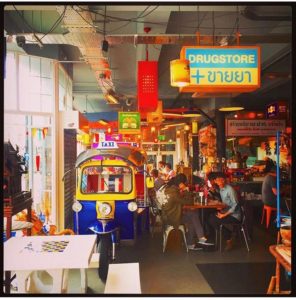
Then, I visited 101 Thai Kitchen on the border between Hammersmith and Chiswick, in West London. This is a small neighborhood restaurant serving absolutely delicious food. They specialize in the cuisine from the Isaan (or Esarn) region of north-eastern Thailand, which means that the food is similar to that of the Laotian cuisine. I started with a papaya salad, followed by a red or green curry (I love them both, so I don’t remember which one I ended up having, but I’m sure that both made it to our table). I certainly wasn’t disappointed this time. For that reason, I decided to be a bit more adventurous with my choice of dessert (and not stick to the otherwise beloved sticky rice). So, I had the tab tim grob – mock pomegranate seeds in coconut milk poured over ice. Simply delicious!
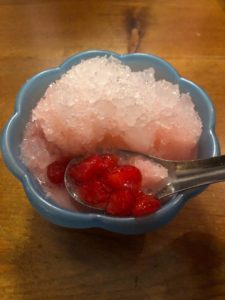
My 3-course Thai menu
So, when Jigna’s invitation arrived, I was excited not only because I love whodunnit mystery dinners, but also because it was a great opportunity for me to prepare a three-course Thai menu. I decided to prepare a tom yum soup as a starter, followed by a green chicken curry. To finish off my banquet, I made a banana sago, a dessert based on mango sago, which is not Thai, but from Hong Kong. To accompany my dinner, I made myself a My Thai cocktail. This was basically my take on the classic Mai Tai cocktail, which (like mango sago) is not Thai. However, I thought it would go down well with my Thai menu (and it surely did).
The quantities I used (and also those stated here) are sufficient for two servings, so I had plenty of food for the following day (it turned out that I was neither the murdered nor the victim).
Appetizer: Tom yum soup
Tom yum is a type of hot and sour Thai soup, usually cooked with shrimp. Some of the ingredients, such as lemongrass, lime leaves and galangal, may be hard to source, especially during lockdown. Instead, I used a bit of shop-bought green curry paste, which is not a standard ingredient.
Ingredients:
4 cups stock (I used vegetable stock)
1 teaspoon chopped garlic
1 teaspoon chopped ginger
1 teaspoon green curry paste
1 teaspoon chilli powder (or fresh chillis)
1 handful of mushrooms
2 tablespoons lime juice
2 tablespoons fish or soy sauce
12 king prawns
12 cherry tomatoes
200 pls (1/2 can) coconut milk
1 teaspoon coconut sugar
Basil
Method:
Place stock in a large pot over high heat and bring to a boil.
When it starts bubbling, reduce heat to medium.
Add the garlic, ginger, curry paste, chilli, mushrooms, lime juice, and the fish or soy sauce. Stir well and simmer for 3 minutes.
Add the prawns and the cherry tomatoes. Simmer for another 3 minutes.
Reduce heat to medium-low and add the coconut milk.
Add the coconut sugar.
Taste and make any adjustments as required.
Sprinkle with some basil.
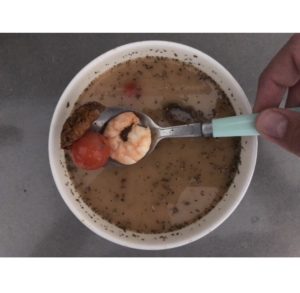
Main course: Green chicken (or prawn) curry
I have to admit that I used a shop-bought green curry paste, so my recipe here doesn’t tell you how to make it. If you want to make it from scratch, the main ingredients that go into the paste are garlic, shallots, ginger, lemongrass, chillies, cumin, coriander and fish sauce.
Ingredients:
For the curry:
1 teaspoon chopped garlic
1 teaspoon chopped ginger
4 teaspoons green curry paste
400 mls (1 can) coconut milk
2 tablespoons fish or soy sauce
1 teaspoon coconut sugar
450 grams chicken, diced (or 12 king prawns)
1 teaspoon lime juice
Cornflour
Basil
For the rice:
1/2 cup basmati rice
200 mls (1/2 can) coconut milk
200 mls water
(the liquids should be double the volume of the rice)
Method:
For the curry:
Heat some oil in a pan, then add the garlic and ginger, followed by the curry paste.
Pour the coconut milk into the pan and let it come to a bubble.
Then, add the fish or soy sauce, the coconut sugar and the chicken (or prawns), and simmer until the chicken (or prawns) are cooked (I used chicken, which I simmered for about 15 to 20 minutes).
Add the lime juice.
If the curry is too watery (it needs to have the consistency of a sauce rather than a soup), add some cornflour to thicken it up (I added 1 1/2 teaspoon).
Sprinkle with some basil.
For the rice:
Put the rice in a bowl, cover it with cold water for about half an hour, before you drain it.
Heat some oil in a pan, then add the rice and finally the liquids, and lower to a medium heat. Once it starts boiling, lower to low heat, cover the pan, and simmer for 15 minutes. Remove from the heat, and let it stand for 5 minutes, before you mix it with a fork.
When ready to serve, pour the curry over the rice.
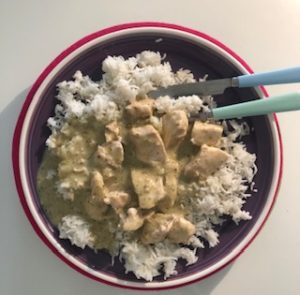
Dessert: Banana sago
This dessert is based on mango sago, which is not Thai, but from Hong Kong. However, both the ingredients and the whole philosophy of the recipe are not that far off from Thai cuisine. Banana sago is really easy to make (as long as you have some tapioca pearls) and very fun to eat; it’s ideal for a dinner party, as you can make it in advance.
Ingredients:
20 grams tapioca pearls
2 bananas, mashed
1/3 can coconut milk (about 150 mls)
Method:
First, cook the tapioca pearls. In a pot over medium heat, bring 2 cups of water to a boil. Add the tapioca pearls and cook for about 10 minutes. Turn off the heat and cover the pan. Let the tapioca pearls stand in the hot water for another 10 minutes, before draining the water.
Meanwhile, blend the mashed bananas with the coconut milk. Then, add the tapioca pearls in the mix.
Divide the mix into two glasses and refrigerate until it’s time to serve.
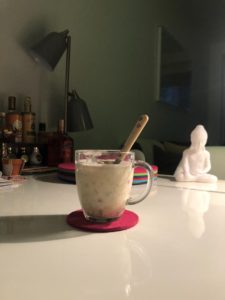
I have to admit that my Thai meal doesn’t look particularly appetizing; in reality, however, it tasted much better than it looks here!
Cocktail: My Thai
This is my take on the classic Mai Tai cocktail, a Polynesian-inspired rum-based cocktail, which was invented in 1944 by Victor J. Bergeron at his Californian restaurant, Trader Vic’s, in Oakland. It is named after the Tahitian word for ‘good’ (so, there’s no connection to Thailand whatsoever).
Ingredients:
5 oz (150 mls) rum (preferably a mixture of white and dark rum, if both available)
1 oz (30 mls) Cointreau (or orange Curaçao)
1 oz (30 mls) lime juice
2 oz (60 mls) orange juice
2 oz (60 mls) pineapple juice
Method:
Pour all the ingredients into a cocktail shaker, filled with ice, and shake. Then, pour into two wine glasses, filled with ice.
Skål!
Meanwhile, whilst the lockdown continues, check out my post:
Self-isolation, social distancing and wellbeing
Stay at home, stay well and stay safe!
Alex
(the London-based Traveling Psychiatrist)